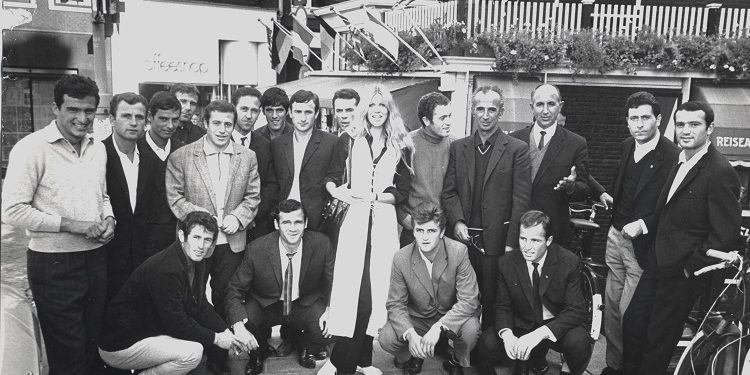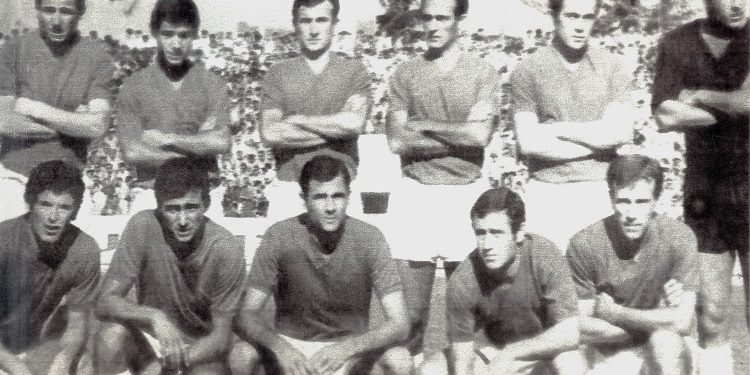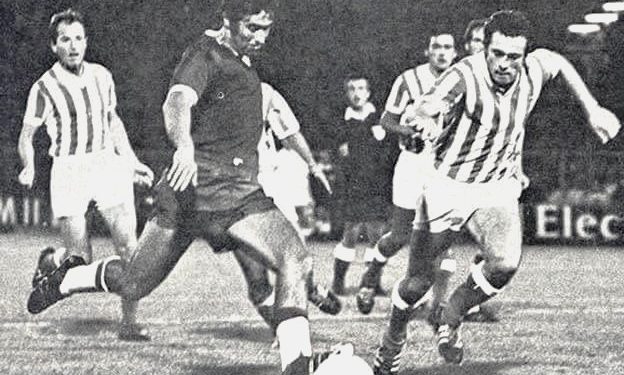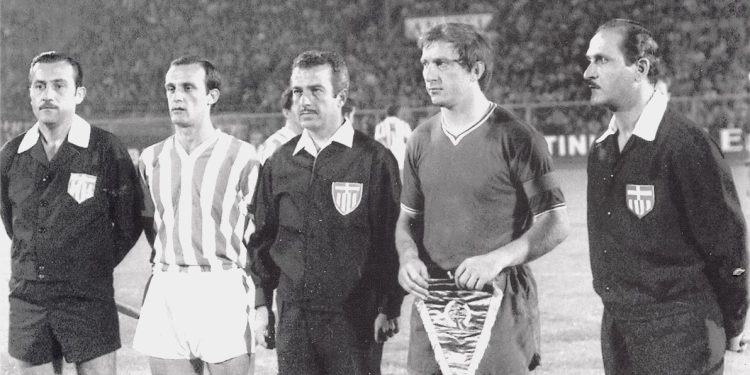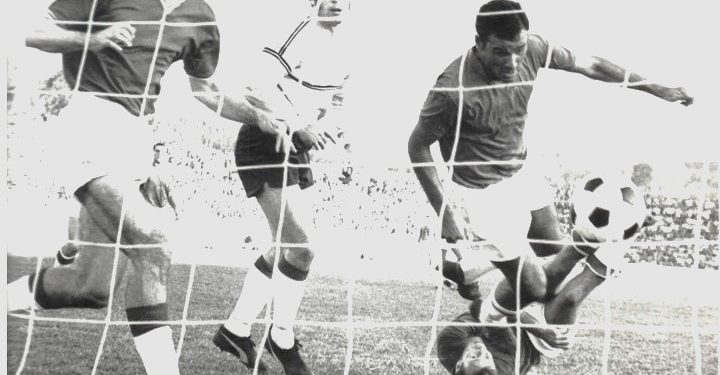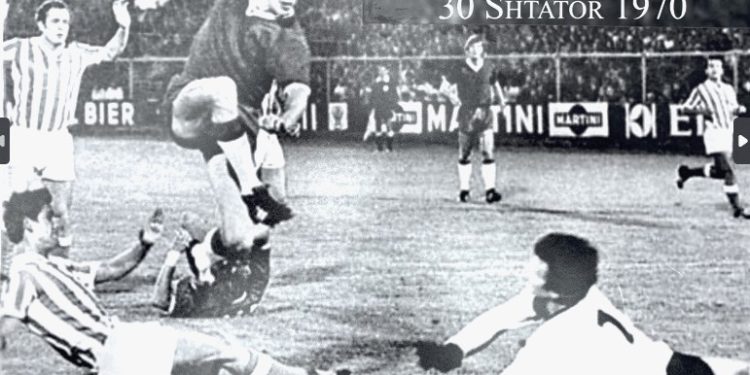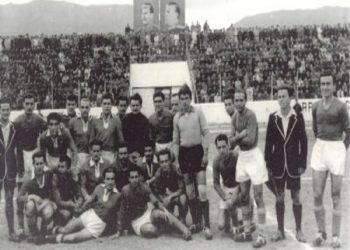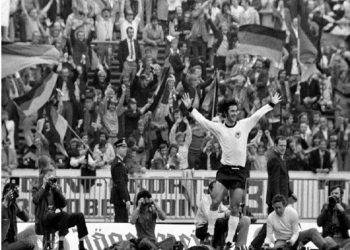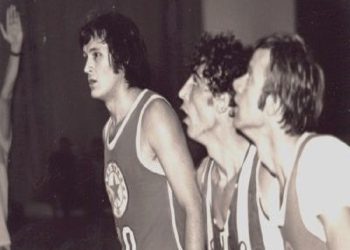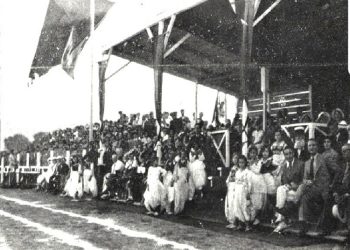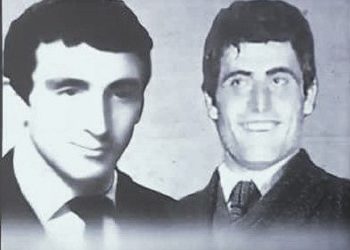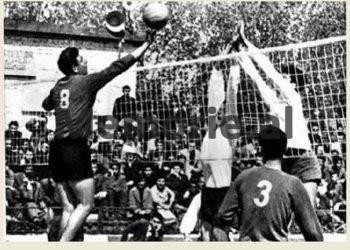From Uvil ZAJMI
Second part
The testimony of Fatmir Frashëri: “On the way back to Belgrade, they isolated us for 24 hours, because the president of the USA, Nixon, arrived there for a visit”!
Continues from last issue
Memorie.al / The return match, the one on September 30, 1970, with “Ajax” in Amsterdam, Holland, has another story. Interest, great curiosity of the Dutch journalists who follow the team to the hotel. Several starters do not travel, the team is without a doctor and the surprise acquisition of goalkeeper Koço Dinella, from “Skënderbeu” of Korça. The whole unknown history of that match that took place half a century ago, where Dzhuxh Kazanxhi, refused the donated shoes, the unforgettable trip by speedboat, then the return to Belgrade, on the same day with American President Nixon! How did the legendary defender of Tirana and the national team, Fatmir Frashëri, remember that 90-minute, with the flying Dutchman, Johan Cruyff and the history of number 14?! If Ajax started the big cycle from Tirana, for “November 17”, the collapse would begin, until the “threat” of falling into the Second Category.
Starting with absences in the formation and reinforcements from other teams!
The “17 November” team left for Amsterdam with four reinforcements, three who played in Tirana: Medin Zhega, Iljaz Çeço and Gani Xhafa, and together with them, goalkeeper Koço Dinella, from “Skënderbeu” and the National Team, was taken, which they announced it when the Korčari players were playing in Vlora against “Flamurtari”, at the weekend in the national championship match. He joined the group and in Holland he left without a single day of training with the team. For biographical reasons, they did not travel and were not part of the Dutch adventure, neither goalkeepers Konomi and Habibi, nor Bixh Bytyçi, nor vice-coach Enver Shehu.
The team consisted of Koço Dinella, Bujar Tafaj, Fatmir Frashëri, Perikli Dhales, Gëzim Kasmi, Aali Mema, A. Nurishmi, Arben Çela, Pavllo Bukoviku, Niko Xhaçka, Iljaz Çeço, Gani Xhafa, J. Kazanxhi, Skënder Hyka, Medin Zhega, Bahri Ishka. The coach is Myslym Alla and the team managers are Jovan Bardhi and Mehdi Agolli. Once the entire staff landed at Amsterdam airport, a group photo together is the only photographic image that accompanies the team on arrival.
Great local media interest
Many journalists at the Dutch airport were present and waited for the arrival of “November 17”, even following him to the hotel, where the team would be accommodated. The interest and curiosity was beyond imagination. The result of the first match had provoked and incited the local sports environment, pushing them to see closely the protagonists of the Tirana challenge, the result of which was a surprise for them. Immediately, many attempts were made, insisting on interviews and photographs on their part, but they were rejected by the football players and the Albanian staff, as this was the orientation given.
The gift shoes that Kazanxhi did not receive…!
The special interest was for Josif Kazanxhiu, the “Tirana giant”, who played in the second half of the first match, scoring the first goal. Initially, they considered it a tactical action, not activating him at the beginning of the challenge, as he was a formation player in the referee’s protocol, but when hours later they were informed what the motive was, they were stunned, not fully believing the cause.
For these reasons, while the team was in the hotel, from the reception, Kazanxhiu was told that someone was waiting for him downstairs: “We were in the room with Xux, – says Pavllo Bukoviku, – when they informed him that a person had brought him a pair of soccer shoes and waiting for him in the lobby, to give it to him. The desire to take them was great, but fear ruled over everyone, especially him. And Xuxi didn’t come down, also due to the fact that they would ask him to take a photo with the donated shoes”, recalled Bukovik.
Fun boat ride
Many journalists at the Dutch airport were present and waited for the arrival of “November 17”, even following him to the hotel where the team would be accommodated. The interest and curiosity was beyond imagination. The result of the first match had provoked and incited the local sports environment, pushing them to see closely the protagonists of the Tirana challenge, the result of which was a surprise for them. Before the meeting, there were many attempts and insistence, for interviews and photographs on their part, but they were rejected by the football players and the Albanian staff, as this was the orientation given.
Regarding that match, Bukovik recalled: “Although I was the starter for a full decade with this team, its spirit and its captain until the ‘Standard’ of Liege (Belgium), I was not activated in the first match in Tirana nor in the second in Amsterdam even today I don’t know the motive”?! Meanwhile, even in this meeting, Cruyff was not active, but stood on the edge of the field, wearing a black suit. “In that meeting, I gave Ali Mema my shoes, which had been brought to me from Italy, and he played with them”, recalled Bukovik.
The Amsterdam match was accompanied by an article in the “Popular Sport” newspaper, with a simple title: “Champions Cup. “Ajax” of Amsterdam – “November 17″ 2-0 (1-0)”. In that meeting, “November 17”, played with the traditional jersey, as shown in the photo before the start, where the two captains, Frashëri and Velibor Vasovic, (Yugoslav), are together with the challenge referees.
In Belgrade together with President Nixon, of the USA
The return to Tirana was scheduled with the airliner and in Belgrade, after a short stay, the airliner to Titograd would be taken. But as soon as the plane took off from the runway in Belgrade, a big storm started and, unable to continue the flight, they forced the plane to land, postponing the trip to the next day. But in Belgrade, there was an unusual event. Exactly on October 1, 1970, following the European tour, after the stay in Italy, Richard Nixon, the president of the United States of America, comes for an official visit to Yugoslavia.
Since very rigorous measures had been taken, in particular for the control and movement of foreigners, such an “isolating” action was also applied to the Albanians, in this case the football team. Regarding this event, the former goalkeeper Bujar Tafaj says: “For this reason, they sent us to a hotel 70 km away. away from Belgrade, we even had two football players in one bed, while downstairs was a noisy casino. When we arrived, two more singers were announced, and the party didn’t stop until morning. Koço Dinella and I did not sleep all night. The next day we left.”
The beginning of an irreversible ruin…!
After returning from the Netherlands, a difficult phase would begin for the capital team. In the following meetings, several losses are recorded in a row, with “Skënderbeu” in the second week, “Dinamon”, from Tirana, “Labinot”, from Elbasan, “Flamurtar” from Vlora and drawing 1-1, with “Lokomotiva” from Durrës . In that season, “Partizani” was declared champion, while “17 November” ranked seventh. Based on some absurd party orientations, where it was said that; “the cycle of this team has ended and renewal is required”, for some footballers and leaders, a storm of suspensions and departures would break out.
As a result, the championships that follow are also disappointing, accompanied by negative results, with poor performances and ranking up to the critical limits of the classification. In the 1973-1974 season, the team is second to last with 21 points, as much as “Warrior” from Gjirokastra, which was last. To help the team with tradition, the Albanian Football Federation “invented” a “play-off”, pitting “17 November” against “Apollonia” of the first place, in the Second Category. The matches ended with the numbers 0-0 in Fier, in the first meeting and 2-0 in Tirana, in the return, the results that guarantee “17 November” the status in the elite of Albanian football.
The former captain of the blue and white Frashëri: “Against ‘Ajax’, the match of his career”!
In Holland, the team arrived two days before the meeting and settled in the “Muze Hotel” in old Amsterdam. How did the legend Fatmir Frashëri, the former captain of the team, remember that match, those 90 minutes
Mr. Frashëri, what atmosphere did you find in Amsterdam?
There was a lot of interest from everyone, but especially from journalists, and there was some uncertainty in the public opinion, starting from the result of the first match, which was intriguing. Even, when I was asked; “how do you think about the match”, I answered “we saw Ajax in Tirana and we are not afraid, while he has not yet seen us in his field”, of course smiling. I remember that the translator was a blonde Dutch girl who spoke Italian and communicated with coach Alla, while I spoke in English.
Was it said that you were injured in that meeting?
I played with a bandaged knee, after an injury some time ago. But during the 90 minutes against “Ajax”, I was hit and then bled on the chin. We didn’t have a doctor, nor a massage therapist, the well-known orthopedic doctor, Panajot Boga, was supposed to travel from Paris, as he was studying there, but he couldn’t come. It was the Dutch doctors who treated me.
The legend, Johan Cruyff, the one who was missing and the history of number 14!
Outstanding player, difficult to find a definition in terms of tactics…! A true universal football performer. Sandro Cioti called the film dedicated to him “Il prophet del goal”. Not a literal striker, but one who has accomplished endlessly, not a defender, but never lost a duel, not a director, but commanded the entire organization of the game like no one else. He played with jersey number 14, which is now the symbol of the Club.
It was his teammate at “Ajax”, Gerrie Muhren, who showed the choice of number. “Usually I used the number 6 shirt and Johan the number 9. Before a transfer meeting, we couldn’t find where my shirt was and Johan offered me his, wearing the 14 himself. The match was more than a triumph and from at that moment, I always wore the number 9, while he wore the number 14. He also wore this shirt with the national team, while at “Barcelona”, no, since the Spanish federation allowed numbers from 1 to 11. Cruyff chose the number 9, but under it, he always wore the number 14″.
In the cycle that started from the “Qemal Stafa” Stadium!
The glorious story of “Ajax” of Johan Cruyff and the “iron soldier”, coach Rinus Mishel, started from Tirana. In 1968, “Ajax” reached the final, but was defeated deeply in Madrid, 4-1 by “Milan”. Meanwhile, he had given the signs of a high-quality team, which had long ago started the cycle for a total football, based on physical-athletic preparation. After having passed the first two rounds, against “November 17” of the Swiss from Basel, they play against “Celtic” of Glazgou nwSkoci, which a year ago, was defeated by “Fejnord” of Rotterdam, in the final of the trophy. 3-0 in Amsterdam and 0-1 in Glasgow.
Then, 1-0 in Madrid for “Atletico” and 3-0 in the Netherlands with goals from Keizer, Suurbier and Neeskens. In the final, they face the Greeks of “Panathinaikos”, who are led by Pushkash and have Antoniadis, the best scorer of the tournament with ten goals. During 90 minutes, the English public at “Wembley” was surprised by the offensive tactics applied by the Dutch, a real football revolution. The match was a monologue, when they scored with Van Dijk, the first goal, after five minutes of play. Rud Krol, a talented left defender and protagonist of the season, did not play injured, but with the constant posting of Dutch players, three minutes before the end, Hari Han scored the second goal and European Champions.
The “Ajaxian” triumphant era has already begun and if we go back a few months ago, the legendary “Ajax” started from Tirana, accompanied by three consecutive titles. Just after the 2-2 draw with “17 November”, on Wednesday, September 16, 1970, to end that season in the London final: “Ajax” – “Panathinakos”, 2-0. “Ajax”: Stuy, Suurbier, Neeskens, Vasovic, Rijnders (Blankenburg), Hulshoff, Suart (46 Han), Van Dijk, Krujf, Muhren, Keizer, Tr. Michelle. Many of them were also protagonists in “Qemal Stafa”.
I N T E R V I EW
Sulejman Starova: “Great, inimitable football”!
How he remembers that match and “Ajax”, former football player and coach and well-known specialist Sulejman Starova, who says: “It would be a miracle if Krujfi played, but he was injured, as we were told later. We are in the 70s, football is followed with great passion. All in love with Ajax”.
Mr. Starova, have you seen “November 17” – “Ajax”, what do you remember?
We were in the first year of the Master’s School and our team, “Skhëndia” was assigned to catch the balls behind the goal. I was from the north gate, I saw Surbier closely, when he scored the first goal. For “Ajax”, it was the first time he came to Tirana, something we knew, heard, I had seen on the black and white television of the time, the final of the Champions Cup, 1968 “Milan” – “Ajax” 4-1, when “Ajax”, was not yet known as a big team.
How do you think it was in Tirana, the first match with “Ajax”, where total football takes place?
I do not say this, but the story. I remember players running, a defender scoring two goals, in the first only when we saw Surbier, in front of our goal, so fast was the maneuvering, the pressure they put on Kasmi, in the midfield, when they surrounded him and grabbed the ball. We all fell in love with “Ajax”. Long hair, physically, big bodies, these elements too, that made him more magnificent. In that season, “Ajax”, after eliminating “17 November”, reached the final and was declared champion. From “Ajax”, the total football was also broadcast to the Netherlands. A modern game module, which surprised the world at that time.
Really, what was that football?
I will refer to Ditmar Kramer, FIFA instructor, former coach of “Bayern” (Munich), European champion, when years later, he came for a seminar in Tirana. He gave an explanation, making a distinction that; “Total football”, was a name that journalists and opinionizes gave it. According to Kramer, the word “total football” orientated the specialists, who asked what this football is, where is its secret? According to Kramer, “Ajax” was a team full of talents, high physical preparation, where, alternately, the regulars Surbier and Krol participated in the attacking phase, as side defenders.
The two central defenders, the German Blankenburg and Hulshof, stood in the classic role of libero and stopper, but you often saw them in attack as well. Then the midfield directed by Han, the tireless Neskens, Myren, they also appeared in front of the goal. The striking force of Van Dijk, Rep on the right, the dribbling, the arching of Kaizer, Suart and Krujfin, leader, strategist everywhere. The whole team exerted high pressure, pressing in every sector that gave them the opportunity to apply a new form of artificial offside. In that trap, large teams fell, up to 5-6 players simultaneously. I remember when Cruyff returned to defense, with his famous sparks.
In the first edition, the coach was Mishel, in the other two trophies, the Romanian Kovač is on the bench…?!
From the “iron” man like Michels, the creator of that football, to “Ajax”, comes a Romanian, Stefan Kovac, who won two championship cups, in a row. Kovac transmitted the ideas of Michels, created good relations with the public, the players, went to training by bicycle, a simple man, a group coach. He gave freedom of action to the players, unlike the “dictatorship” of Michels. We all asked the question; how is this great team with a Romanian coach possible?!
There are many commentators who consider this game system to be a failure, starting with the Dutch national team, without any trophies at its peak?!
The Netherlands of the ’74 World Cup reached the final with goals, a spectacular game, where everyone scored, with an extraordinary Cruyff. But in front was a colossal Germany. History was repeated in “Euro 88”, when the Netherlands with Michels on the bench, although he did not see the total football, created by him, but with other champions in the team, such as Van Basten, Gulit and Rijkaard, sensationally won the continental trophy.
Starova, the last question to close it: Although years, decades, eras, pass and the scheme and modules change. Is it said that something connects them?
Of course, there is a thread that connects them even though the schemes and strategies differ. At the end of the day, it’s always the great players who make the difference. Of course, every tactic is connected and remembered with the team that performed it best. Memorie.al




